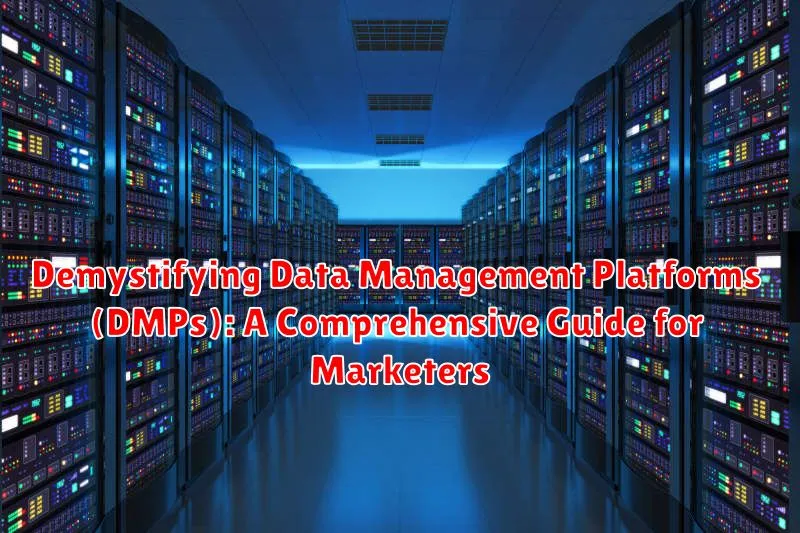In today’s data-driven marketing landscape, understanding and leveraging Data Management Platforms (DMPs) is no longer optional – it’s a necessity. This comprehensive guide aims to demystify DMPs, providing marketers with a clear understanding of their functionality, benefits, and implementation strategies. From first-party data collection to third-party data integration, we will explore how DMPs empower marketers to create more personalized and effective campaigns, ultimately improving ROI and driving business growth. As global marketing becomes increasingly complex, a solid grasp of data management principles and tools like DMPs is crucial for staying ahead of the competition.
This guide will delve into the core components of a DMP, explaining how it collects, organizes, and activates audience data. We’ll explore different types of data sources, including online behavioral data, CRM data, and demographic data, and how these sources can be integrated within a DMP to build comprehensive customer profiles. Furthermore, we will discuss the various use cases of DMPs, from targeted advertising and personalization to attribution modeling and audience segmentation. Whether you’re a seasoned marketing professional or just starting your journey into the world of data-driven marketing, this guide will provide you with the knowledge and insights you need to effectively leverage DMPs to achieve your business goals.
What is a Data Management Platform (DMP) and Its Core Functions?
A Data Management Platform (DMP) is a centralized data warehouse used by marketers and advertisers to collect, organize, and activate audience data from various sources. It serves as a hub for understanding and reaching specific consumer segments. The primary function of a DMP is to enhance targeted advertising efforts by providing a comprehensive view of potential customers.
Core Functions of a DMP:
- Data Collection: Gathers data from various online and offline sources, including websites, mobile apps, CRM systems, and third-party data providers.
- Data Organization: Classifies and organizes raw data into defined audience segments based on demographics, interests, behaviors, and other relevant attributes.
- Audience Segmentation: Creates granular audience segments for targeted advertising campaigns.
- Data Activation: Exports audience segments to ad platforms, demand-side platforms (DSPs), and other marketing channels to deliver personalized ads.
DMPs enable marketers to improve ad targeting, personalize marketing messages, and optimize advertising spend.
Key Components and Architecture of a DMP
A Data Management Platform (DMP) is a sophisticated system composed of several key components that work together to collect, organize, and activate data. Understanding these components is crucial for marketers seeking to leverage DMPs effectively.
Data Ingestion: This is the process of collecting data from various sources, including first-party, second-party, and third-party data providers. It involves integrating with different platforms and using APIs to import data into the DMP.
Data Storage: DMPs require robust and scalable data storage capabilities to handle large volumes of data. Cloud-based solutions are commonly used to ensure flexibility and cost-effectiveness.
Data Processing and Segmentation: Once data is ingested, it needs to be processed, cleaned, and segmented. This involves using algorithms and rules to identify relevant audience segments based on various attributes.
Audience Activation: The final component involves activating the audience segments across different marketing channels, such as display advertising, social media, and email marketing. This requires integrations with ad servers, DSPs (Demand-Side Platforms), and other marketing technologies.
The Role of First-Party, Second-Party, and Third-Party Data in a DMP
Data Management Platforms (DMPs) aggregate and organize data from various sources to create comprehensive user profiles. A crucial aspect of a DMP is its ability to leverage different types of data: first-party, second-party, and third-party data. Each type plays a distinct role in enhancing audience understanding and targeting accuracy.
First-party data is collected directly from your own sources, such as website activity, CRM data, and customer surveys. This data is considered the most valuable because of its accuracy and direct relationship to your business. DMPs use first-party data as a foundation for building audience segments and personalizing customer experiences.
Second-party data is another organization’s first-party data that is shared directly with you. This data can provide valuable insights and expand your reach. It’s important to establish clear agreements regarding data usage and privacy when working with second-party data.
Third-party data is data collected from various sources by external data providers. This data is typically broader in scope and can be used to reach new audiences and augment existing customer profiles. When utilizing third-party data, it’s crucial to ensure data quality and compliance with privacy regulations.
Benefits of Using a DMP for Targeted Advertising

A Data Management Platform (DMP) offers significant advantages when it comes to targeted advertising, primarily by enhancing the precision and effectiveness of ad campaigns. One of the key benefits is improved ad relevance, ensuring that consumers are presented with advertisements that align with their interests and needs, thereby increasing engagement and conversion rates.
Furthermore, DMPs enable better audience segmentation, allowing marketers to group users based on shared attributes and behaviors. This granular segmentation enables the creation of tailored ad creatives and messaging for each segment, leading to higher click-through rates and improved return on investment (ROI).
DMPs also facilitate reduced ad waste by minimizing the exposure of ads to irrelevant audiences. This not only optimizes ad spending but also enhances the overall user experience by preventing consumers from being bombarded with unwanted advertisements. Additionally, the enhanced measurement and analytics capabilities of DMPs provide valuable insights into campaign performance, enabling continuous optimization and improvement.
How DMPs Integrate with Other Marketing Technologies
Data Management Platforms (DMPs) do not operate in isolation. Their true value is unlocked through seamless integration with a variety of other marketing technologies. These integrations enable a cohesive and data-driven approach to marketing.
Key integrations include:
- Demand-Side Platforms (DSPs): Enables real-time bidding (RTB) and programmatic advertising using DMP audience data.
- Supply-Side Platforms (SSPs): While less direct, DMP data can inform publisher strategies through shared insights via DSPs.
- Customer Relationship Management (CRM) systems: Enhances CRM data with DMP insights for more comprehensive customer profiles.
- Email Marketing Platforms: Allows for personalized email campaigns based on DMP audience segments.
- Analytics Platforms: Provides a holistic view of campaign performance by combining DMP data with website and app analytics.
This interconnected ecosystem allows marketers to leverage DMP insights across all their marketing efforts, creating a unified and personalized customer experience.
Using a DMP to Improve Audience Segmentation and Targeting
Data Management Platforms (DMPs) empower marketers to significantly enhance audience segmentation and targeting strategies. By centralizing and organizing diverse data sources, DMPs facilitate the creation of highly granular audience segments based on demographics, interests, behaviors, and online activity.
A DMP enables precise targeting by allowing marketers to define specific criteria for each segment. This ensures that advertising campaigns are delivered to the most receptive audiences, maximizing ROI and minimizing wasted ad spend.
Improved audience segmentation translates into more personalized and relevant messaging. By understanding the unique characteristics of each segment, marketers can tailor their content and offers to resonate with specific audience needs and preferences. This enhanced personalization can lead to increased engagement, higher conversion rates, and improved customer loyalty.
Furthermore, DMPs facilitate look-alike modeling, which allows marketers to identify new audiences that share similar characteristics with their existing high-value customers. This expands reach and enables the acquisition of new customers who are likely to be interested in the brand’s products or services.
DMP Use Cases: From Personalization to Predictive Analytics
Data Management Platforms (DMPs) offer a wide range of applications beyond simple data storage. They empower marketers to leverage audience data for sophisticated strategies like personalization and predictive analytics.
Personalization: DMPs enable personalized ad experiences by matching ads to specific audience segments based on their demonstrated interests and behavior. This can lead to higher engagement and conversion rates.
Predictive Analytics: By analyzing historical data, DMPs can predict future customer behavior. This enables marketers to proactively target potential customers and optimize marketing campaigns for maximum impact. For example, predicting which customers are most likely to churn can allow companies to proactively implement retention strategies.
Challenges and Considerations When Implementing a DMP
Implementing a Data Management Platform (DMP) can significantly enhance marketing efforts, but it’s crucial to acknowledge the potential challenges and considerations beforehand. A primary concern is data quality. Inaccurate or outdated data can lead to ineffective targeting and wasted ad spend. Therefore, robust data validation and cleansing processes are essential.
Integration complexity is another significant hurdle. DMPs must seamlessly integrate with existing marketing technologies, such as CRM systems, ad servers, and analytics platforms. Incompatibility issues can hinder the flow of data and limit the DMP’s effectiveness.
Cost is also a major consideration. DMPs can be expensive to implement and maintain, requiring significant investment in software, infrastructure, and personnel. Organizations must carefully assess their budget and determine whether the benefits of a DMP justify the costs.
Furthermore, data privacy and compliance are paramount. Organizations must adhere to regulations such as GDPR and CCPA, ensuring that data is collected and used ethically and transparently. Failure to comply with these regulations can result in severe penalties and reputational damage.
The Future of DMPs in a Cookieless World

The impending demise of third-party cookies is forcing a significant evolution in the role and functionality of Data Management Platforms (DMPs). While historically reliant on these cookies for audience targeting and data enrichment, DMPs are adapting to a future where privacy and first-party data reign supreme.
Here’s how DMPs are evolving:
- Focus on First-Party Data: DMPs are increasingly emphasizing the ingestion, organization, and activation of first-party data, becoming central hubs for customer data management.
- Contextual Advertising: Leveraging contextual signals to deliver relevant ads without relying on individual user tracking is becoming more important. DMPs will enhance their capabilities in this area.
- Enhanced Identity Resolution: Investing in solutions that can accurately identify users across devices and channels using privacy-compliant methods (e.g., hashed email addresses) is critical.
- Integration with CDPs: Collaboration with Customer Data Platforms (CDPs) becomes vital, with CDPs managing identified customer data and DMPs focusing on anonymous data for broader reach.
DMPs will need to offer robust privacy controls and transparency, ensuring compliance with regulations like GDPR and CCPA. The future of DMPs lies in their ability to navigate the privacy-first landscape and provide value through enriched first-party data and innovative, privacy-conscious targeting methods.
Choosing the Right DMP for Your Business Needs
Selecting the right Data Management Platform (DMP) is crucial for maximizing your marketing ROI. The ideal DMP should align with your specific business objectives, data strategy, and technical capabilities.
Key Considerations:
- Data Sources: Ensure the DMP can integrate with your existing first-party data sources and access relevant second-party and third-party data.
- Integration Capabilities: Verify seamless integration with your current marketing technology stack (e.g., DSP, CRM, analytics platforms).
- Scalability: Choose a DMP that can handle your current data volume and scale as your business grows.
- Reporting and Analytics: The DMP should provide robust reporting features to track performance and optimize campaigns.
- Compliance and Security: Ensure the DMP adheres to relevant data privacy regulations (e.g., GDPR, CCPA) and has strong security measures in place.
- Pricing Model: Understand the DMP’s pricing structure and ensure it aligns with your budget.

